THE CLANDON BARROW LOZENGE.
In 1882 a burial mound, located near Maiden Castle, Dorchester
area, was excavated by Edward Cunnington and an assortment of valuable artefacts
were found. These included a gold lozenge, very similar to the Bush Barrow
Lozenge (which had been found 74 years earlier and only about 40 miles away
at a mound grave near Stonehenge). Curiously, in the earlier, 1808 discovery
there was also a Cunnington present...in that case William Cunnington...in
company with Sir Richard Cott Hoare.
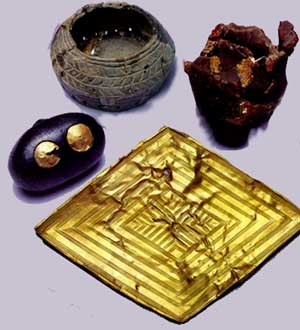
Some of the "Wessex" grave goods recovered from
Clandon Barrow in 1882. Items included a macehead made of Kimmeridge shale
or jet stone (with 5 inlaid gold bosses) and a broken dagger. The dark object
in the photo, showing two gold semi-spheres, is the macehead and the fragmented
vessel to the upper right was formerly an incense cup. The pot to the upper
left is but one of the types of burial pots or beakers that were commonly
found in Beaker folk graves. Many burial beakers of this era (3rd or 4th millennium
BC) were bell shaped and adorned with multiple lozenge patterns, similar in
style to the main find at Clandon Barrow...the intricately incised gold lozenge.
The similarity in style between the Bush Barrow Lozenge and
the Clandon Barrow Lozenge, coupled with the relatively short distance between
the archaeological sites where each artefact was found, has caused some archaeologists
to comment that both lozenges were probably fabricated by the same artisan
(See The Wessex culture: a minimal view, by John Coles and Joan
Taylor, Antiquity, XLV, 1971, pages 6-13).
Whereas an examination by Coles and Taylor of these Wessex goldwork,
lozenge artefacts, 'suggests to them that the individual hand of a particular
craftsman can be recognised', the two objects can also be compared mathematically.
THE PRECISE MEASUREMENTS OF THE CLANDON BARROW LOZENGE.
Gaining precise measurements of the Clandon Barrow Lozenge has
been difficult, as no known publication, listing its exact dimensions, seems
to exist. Assistant Curator of the Dorset County Museum, Mr. Peter Woodward,
wrote the following in response to this researcher's request for exact measurements:
'The Lozenge has not as yet been the subject of a machine
scanned isometric survey. This will be the subject of a major survey of such
items in the next few years. In the meantime I can only supply you with the
attached image, and refer you to Stuart Needham
of the British Museum who surveyed the object macroscopically for his own
research some two years ago. I do not think that you will be able to derive
appropriate measurements remotely for the research you have formulated'.
PJW
The attached image that
Mr. Woodward was kind enough to send showed a "10 centimetre" rule
sitting adjacent to the Clandon Barrow Lozenge. The photo itself had been
professionally taken, with the lozenge lying at 90-degrees to the camera lens.
It initially appeared that there was no significant optical distortion in
the photo-representation and an attempt was made to scale the photo, accordingly,
in AutoCAD.
On the 11th of June 2003 refined measurements of the Clandon
Barrow Lozenge were sent by Dr. Joan Taylor of Liverpool University. Dr. Taylor
listed the official length and breadth measurements as:
- External diameter = 15.5 cm long X 11 cm wide.
- Innermost diamond (external diameter) = 5.92 cm long X 4.32 cm wide.
- One of the 4 sides has a given length of 9.70 cm.
- Another side has a given length of 9.290 cm.
- The edge skirt, which was designed to be angled downward at 90-degrees to
the face is .200 cm wide.
- The thickness of the beaten gold plate, from which the lozenge is built,
is .08mm thick.
- The length of 10 centimetres would equate to 3.9370078 British Standard
inches.
All of the above determinations were made with vernier calipers and a micrometer
to measure the thickness of the gold plate. With the receipt of these more refined
measurements some minor adjustments were made to the earlier AutoCAD scaling,
which had been based solely upon Mr. Woodward's photo.
Again, however, the Clandon Barrow Lozenge's "official" measurements
for length and breadth @ 15.5 cm long and 11 cm wide, seem, clearly, to be "rounded"
to the nearest mm.
THE GENERAL CONDITION OF THE ARTEFACT.
The Clandon Barrow Lozenge is fairly buckled and bent across
its surface, but is still in a sufficiently good condition to allow for accurate
assessment of its true geometric characteristics. It is certainly in a somewhat
more battered condition than its slightly larger counterpart, the Bush Barrow
Lozenge, for which accurate measurements (to within a millimetre) exist.
In this drawn representation of the Clandon Barrow Lozenge,
all damage has been faithfully reproduced, including a small hole sitting
adjacent to the 4th inward set of pattern lines. The outer "fold down"
edge-skirt protrudes unevenly in places, but the true location of the former
outer edge is, for the most part, quite clear.
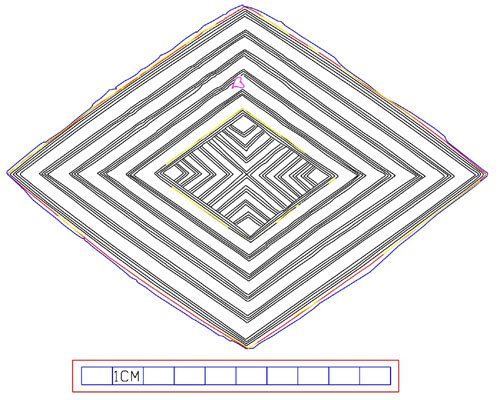
The "partially battered" Clandon Barrow gold Lozenge,
in reasonable enough condition that it is still able to tell us the mathematical
principles for which (and by which) it was conceived. The outermost blue line
indicates the damaged and irregular, flared-out skirt, which should sit evenly
at 90-degrees to the face. The red/ yellow line, just inward from the blue
line, indicates the outer edge of the lozenge. Inward from the red/ yellow
line are 6 diminishing sets of diamonds, made up of, visually, 4 lines per
diamond. The positions between the lines represent 3 raised humps made with
an incising tool. It is important to recognise that on both the Clandon Barrow
Lozenge and the Bush Barrow Lozenge there are 3 raised humps per diamond (a
shared design attribute).
THE RATIO RELATIONSHIP BETWEEN THE CLANDON AND BUSH BARROW
LOZENGES.
The outer dimensions of the Bush Barrow Lozenge (Devizes
Museum collection) are 185 x 156 mm. The dimensions from the corners of the
outermost engraved lines are 180 x 153 mm. In consideration of the somewhat
battered state of the artefact and the fact that the official dimensions are
only correct to the nearest millimetre it would not seem unreasonable to deduce
that the intended, design length was 185.166mm or 7.29 inches. Under such
circumstances, two lengths would represent one Greek pygon (14.58 inches)
or 1.25 Roman feet of 11.664 inches.
Note: The Roman foot was found to be 11.664 inches by John
Greaves, professor of geometry, who in 1639 went to Rome specifically to ascertain
the length of an ancient Roman foot. Greaves located a monument of Roman architect,
Stalius Asper and measured bas relief instruments used by him in the first
century A. D. Greaves concluded, after careful investigation, that the Roman
foot, 'contained 1944 such parts as the English foot contains 2000'. This
means a Roman foot of 11.664 inches.
Several ancient civilisations used the
11664 set of numbers in their lengths and volumes, including the Egyptians
(within their volumes standard of a Theban, Beshu and Honnu). The Roman Pace
was 58.32 inches. The Roman, Greek and Hebrew measurements were adopted from
the Sumerians, Babylonians and Egyptians, who were all using (what eventually
became known as) the British Standard inch. It is very clear that at an early
era all of the primary lengths of measuring rods, shared between cousin nations,
were in perfect ratio to each other and all were using the same base increment
(1 inch). This fact becomes particularly vivid when one does comparative analysis
related to the cubic inch and foot capacities of ancient volume vessels. Coupled
with that observation is the realisation that there was a practical need for
easily decipherable "standards" between the cousin "trading
nations" of the early Mediterranean and Europe.
The refined, official length of the somewhat distorted Clandon
Barrow Lozenge is 6.1024 inches, which is tantalizingly close to the official
width of the Bush Barrow Lozenge. If, as John Coles and Joan Taylor have suggested,
'the individual hand of a particular craftsman can be recognised',
then it is not unreasonable to surmise that the width of the Bush Barrow Lozenge
and the length of the Clandon Barrow Lozenge were intended to be one and the
same measurement.
The ("rounded") width of the
Bush Barrow Lozenge, given as 156mm, translates to 6.142 inches.
So, we have two somewhat battered artefacts,
both expressing a very close dimension just in excess of 6.1 inches. Let's
explore what this measurement could mean, based upon numbers and mathematical
methodologies occurring on several continents. We must find a very practical
purpose related to why such an outer dimension (just over 6.1 inches) would
have been chosen for both lozenges when they were newly fabricated and in
pristine condition. Here are the most outwardly apparent possibilities:
- One of the foremost conversion values used in antiquity was 58.333333. It
was dual rendered as 58.32 in applications to do with the lunar cycle or cubic
inch volume measure divisions shared by several ancient civilisations. The
length of 58.33333 inches became the Roman Pace (based upon 5 Roman feet of
either 1.166666 inches (overland reading) or 11.664 inches (lunar reading).
The Greeks, similarly, had several forms of foot, depending upon the calculation
requirements at any given time. The "common cubits" used by ancient
civilisations were 1.166666 to 1 less in length than their "Royal Cubit"
counterparts.
- 360 inches or degrees ÷ 58.33333 = 6.171428572 inches or
degrees of arc (12/700ths of 360-degrees).
- 360 inches or degrees ÷ 58.32 = 6.172839506 inches or
degrees of arc.
Another very important ratio to consider in this instance is the PHI ratio
of 1.6180339 to 1, which is found all over significant structures of antiquity.
At Stonehenge many of the major circles are in a PHI ratio to each other. A
stone on the Avenue marks the rim of a circle with a diameter of 466 feet (÷
1.6180339) = 288 feet...the diameter of the Aubrey Circle (÷ 1.6180339)
= 178 feet... the diameter of the "Y" Holes Circle (÷
1.6180339) = 110 feet...the diameter of the Sarsen Circle.
Another way of expressing the PHI ratio is to divide 1 by PHI. Therefore 1
÷ 1.6180339 = .6180339. In calculation methodology each of
the "PHI" diminishing Stonehenge circles could, equally, be multiplied
by .6180339 to achieve the same result.
- Another possibility for the intended dimensions through sections of both
the Bush Barrow and Clandon Barrow lozenges is, therefore, 6.18034 inches.
This small elongation is very realistic in consideration of the condition
of the lozenges, where the end points appear to have suffered impact damage
and are slightly rounded.
Again, it must be emphasised that these (selfsame) exterior use measurements
on the lozenges, whatever choice was made originally by the mathematician/ artisan,
had to be of tremendous importance.
THE CLANDON & BUSH BARROW LOZENGES
USED TO CREATE TUBS OF EXACTLY 1 BUSHEL
For a king or provincial governor/ priest,
trying to keep peace within regional society, few things were more threatening
to harmony than "short measures" being metted out in the market
place. This problem has required eternal vigilance, worldwide, since time
immemorial. The responsibility to know what constitutes a correct measure
in weight, volume or length, as well as the enforced maintenance of precise
standards, was always a primary function of localised leadership.
The original bushel of England was, undoubtedly,
based upon a Sumerian/ Babylonian volume called a Homer, which was 21600 cubic
inches. The English Winchester bushel was, originally, 2150.42 cubic inches
or very close to 6 X 6 X 60 cubic inches (2160 cubic inches...1/10th of a
Homer). In ancient England the tub created to measure out a correct bushel
volume was described as, "any round measure with a plain and
even bottom, being 18.5 inches wide throughout and 8 inches deep". This
surviving volume from the old English Winchester Standard, undoubtedly, had
a pedigree founded upon older traditions, passed down from distant ancestors.
In the opinion of this researcher, the Winchester bushel represents
a "drifted" standard from very olden times, inasmuch as the
2150.42 cubic inch volume is without meaning, whereas a 2160 cubic inch volume
would be highly significant. It seems plausible to assume that the original
coding of the bushel was "lunar", like so many other ancient
national standards of the Mediterranean/ European region. The coded numerical
significance of the capacity volume had, undoubtedly, been lost after the
arrival of Roman Christianity in Britain and subsequent persistent efforts
by the church to eradicate all things pagan.
This exact description for a bushel (given above) became the
volume of the American bushel, which is 2150.42 cubic inches ...derived
from the old Winchester Standard and, thankfully, still preserved in the US.
A close formula for finding this bushel could be rendered: 360
inches ÷ 58.33333 = 6.171428572 X 3 = 18.51428572 inches diameter
(then using PI X the radius squared) = 9.257142858 inches (squared) = 85.69469389
X PI = 269.2178208 square inches (for the bushel tub base) X 8-inches high
= 2153.742566 cubic inches. Using the 360 ÷ 58.32 formula
the final capacity = 2154.727472 cubic inches.
Using the PHI based rendition listed above at 6.18034 inches
the final capacity is: 6.18034 X 3 = 18.54102 inches ÷ 2
= 9.27051 (squared) = 85.94235566 X PI = 269.999 square inches X 8 = 2160
cubic inches...with a margin of error of .033 of a cubic inch.
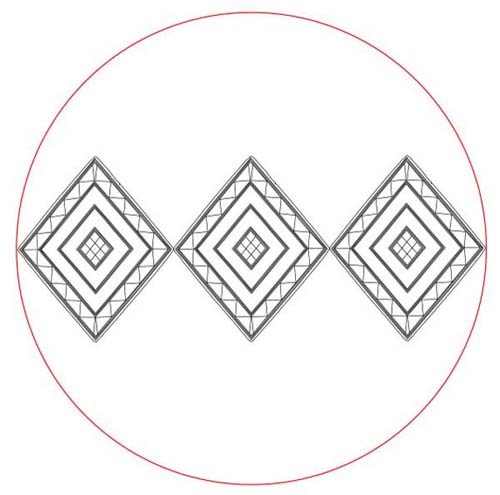
The red circle is perfectly sized (18.5411617 inches diameter) to create
the base of a bushel tub container, wherein the
sides have to extend above the base board surface exactly 8-inches. If the barrel
were then filled to a level top surface with grain and screeded flat, the cubic
capacity would be 2160 cubic inches...or one ancient English bushel (1/10th
of a Babylonian Homer). It seems obvious that the Bush Barrow and Clandon Barrow
lozenges were used in this very practical application...to create perfect bushel
containers, or to check the integrity of containers used by merchants engaged
in measuring out cubic quantities for sale to the public. Any irregularity in
the roundness or symmetry of containers could be checked by the king's marketplace
inspector... the protector of the buying public, who carried the official "master
standard"gold, assaying lozenge of office. The diameter of the above circle
would be, essentially, 3 lengths of the Clandon Barrow
Lozenge.
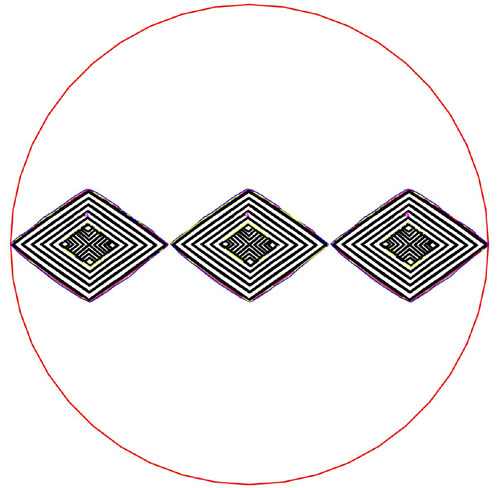
The Clandon Barrow lozenge, configured to exact official dimensions and
showing how close it would come to providing the precise diameter for a Bushel
tub's base @ 2160 cubic inches. The lozenge is somewhat damaged over its top
surface and at its end points and this could now contribute to a very slight
shortfall in its original design length.
WHY PHI?
In consideration of the 3 possibilities mentioned for
a length code on the Clandon Barrow Lozenge, which complied to the Bush Barrow
lozenge's width code, the most plausible choice for both is 6.18034 inches
(the result of dividing 10 by PHI @ 1.6180339). The reason for this is that
precise, standard cubic volume vessels could be easily fabricated according
to any of the commonly used volume standards found around the ancient Mediterranean
and, presumably, early Europe. Let's consider some of these:
- 1 Egyptian Theban @ 11664 cubic inches...6.75 cubic
feet. A Theban would be 5.4 ancient bushels of 1.25 cubic feet.
- 1 Greek Metretes @ 2332.8 cubic inches...1.35 cubic
feet. A Metretes would be 1.08 ancient bushels of 1.25 cubic feet.
- 1 Hebrew Homer @ 28512
cubic inches... 16.5 cubic feet. A Homer would be 1.32 ancient bushels of
1.25 cubic feet.
- 1 Roman Amphora @ 1900.8 cubic inches...1.1 cubic feet. An Amphora would
be .88 ancient bushels of 1.25 cubic feet.
- 1 Babylonian Archane @ 129600 cubic inches...75 cubic feet. An Archane would
be 60 ancient bushels of 1.25 cubic feet.
Although the cousin nations made their measures either the same or in easily
calculable ratios to their trading neighbors, they also required precise formulas
for fashioning very individual circular jar or tub vessels for their own coded
volumes of preference. It would appear, very strongly, that the 6.18034 inch
increment was used universally to calculate the bases for all "official
standard" measuring tubs or vessels used by the great civilisations of
the ancient Mediterranean Basin. For example:
- 1 Egyptian Theban tub @ 11664 cubic inches could have a circular base of
18.54102 inches (3 X 6.18034") and
sides 43.2 inches high. There would be 270 X 43.2 cubic inches in 11664 cubic
inches The length of the Great Pyramid is 432 Hebrew/ Celtic Royal Cubits
of 21-inches).
- 1 Greek Metretes vessel @ 2332.8 cubic inches (actually a liquid volume)
could have a base diameter of 12.36068 inches (2
X 6.18034") and sides 19.44 inches high. The 19.44 number
was used for lunar calculations and the Roman Pace @ 58.32 inches was 3 X
19.44 inches. There would be 120 X 19.44 cubic inches in 2332.8 cubic inches.
- The Hebrew Homer @ 28512 cubic inches could have a circular base diameter
of 30.9017 (5 X 6.18034") and sides
that were 38.016 inches high. The number 38.016 is a navigational use number
and the Roman Amphora @ 1900.8 cubic inches was 50 X 38.016. Alternatively
the Hebrew Homer @ 28512 cubic inches was 750 X 38.016 cubic inches.
- The Roman Amphora @ 1900.8 cubic inches could have a circular base diameter
of 12.36068 inches (2 X 6.18034")
and sides 15.84 inches high. The 15.84 number was used in navigation and there
would be 120 X 15.84 cubic inches in 1900.8.
- The Babylonian Archane @ 129600 cubic inches could have a circular base
diameter of 49.44272 inches (8 X 6.18034") and
sides that extended above the base 67.5 inches. The number 129600 was used
in navigation. The sum of 12960 years is half the cycle of the Precession
of the Equinoxes. There would be 1920 X 67.5 cubic inches in 129600 cubic
inches.
Any precise volume standard used by the cousin nations could be fashioned with
tremendous precision as a circular vessel when the base diameter was in allotments
of 6.18034 inches. The vessels could be more squat than tall or vice-versa...
it didn't matter, as long as the base retained the 6.18034 inch progression
in it's diameter. The same formula, in lesser ratio, could be used to fabricate
tumblers, jars or everything down to small cups for use by wine, beer or mead
vendors within commercial premises.
The 6.18034 number could also be pressed into service if it was necessary to
lay out circular land plots of precise square footage area. For example, an
Egyptian Pyramid Acre of 28800 square feet would be a circle with a diameter
of 31 X 6.8034 feet. An acre of 43560 square feet (1 furlong X 1 chain) would
be a circle of 38.1 X 6.18034 feet.
It seems evident that the old Scottish Ell (37 inches) was, quite simply, 6
X 6.18034 inches originally (37.08204 inches). The Scottish Ell would work very
fluidly in laying out circles of desired square footage area with reasonable
calculation ease. This is, undoubtedly, one of the surviving measurements carried
from Egypt to France and Britain by about 5000 BC. Half a Scottish ell could
be used effectively to make bushel barrels or tubs.
It is this researcher's conclusion that the intended, original width of the
Bush Barrow Lozenge and the intended, original length of the Clandon Barrow
Lozenge were 6.18034 inches...a direct reflection of the PHI ratio...10 inches
÷ 1.6180339. In consideration of the known cubic capacities of ancient
Mediterranean Basin volume vessels, no other external measurement would be more
important.
*For a deeper explanation of several closely related variations on mathematical
codes that can be interpreted to exist within the lengths and breadths of the
Clandon Barrow and Bush Barrow lozenges, see Footnote.
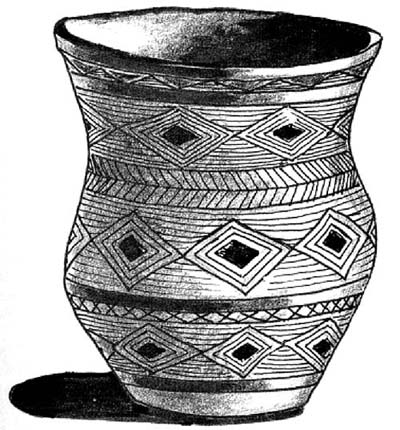
This is a burial beaker taken from a Neolithic Age grave
at West Kennet Long Barrow. These beakers, invariably, accompanied the deceased
in any burials of that era. Although the many thousands of lozenge depiction's
have, for the most part, been found in Great Britain (predominantly in Beaker
folk graves or panels within monuments) the lozenge symbol is found, as a
cultural expression, from the Middle East to Oceania. The "Tapu"
cloths of the Pacific Islands will often display strings of lozenge patterns
and these are, generally, "lozenges within lozenges" (as in Beaker
pottery). The lozenge is a primary symbol recurring in the Maori culture of
New Zealand, where the ancient, pre-Maori "stonebuilders" left standing
stone circles and British-type megalithic structures all over the ancient
landscape. The long established "stonebuilders" of New Zealand were
hunted to extinction by the newly arrived Polynesians from Hawaiki, after
1300AD. Ancient surveying markers and other structural evidence upon the New
Zealand landscape shows, conclusively, that the former "stonebuilders"
had a cultural link to Britain, Continental Europe and the Mediterranean ...as
well as links to South America. The earlier, non-Polynesian burials of New
Zealand were very often in a trussed, sitting or foetal position...the same
as the Beaker folk of Britain.
The pictorial evidence found upon numerous artefacts or motifs
across (especially) ancient Britain strongly suggests that "lozenge"
devices were used in very important measuring or assaying functions to regulate
society and maintain fair trading standards in the marketplace. This everyday,
mundane social necessity took on (or developed into) "religious"
significance and the information contained within the "special"
mathematical knowledge (held by the priest/ overseers... "the few
set aside to bless the many"... and related to cycles of the Sun
and Moon, or the size of the Earth, etc.) was sent (symbolically) with the
deceased into the afterlife (in the form of a funerary beaker).
The inclusion of simple beaker pots in the Beaker people burials
of Britain seems to be a simplified version of the (Dynastic Egyptian, forward
to the Christian era) ritualised mummification burials of Egypt. The Egyptian
burials became increasingly more elaborate as time went on and the decadent
but lucrative funeral industry developed. In late era Egyptian burials the
deceased was armed with instructions on how to proceed in the afterlife (the
very detailed and long "Book of the Dead"...up to 162 chapters).
There were also copious assortments of potions, amulets and magical paraphernalia
to purchase for the journey. These were to ensure that the deceased had everything
needful on board to negotiate the perilous path (fraught with many dangers
and monsters) to heaven (Orion).
The Beaker people made the same journey with their simple clay
pot (symbolically/ spiritually containing special navigational knowledge?),
encrypted within adorning "lozenge" patterns. For the Beaker people,
as with the Egyptians overseen by Ptah (architect of the universe... depicted
on the Egyptian Hypocephalus funerary amulet with his special measuring square),
all was prepared, checked and a safe course in the afterlife charted to perfection...beam
me up D' anu.
The people of Britain (and Greater Europe) had formerly lived
in Egypt and its satellite countries...but had abandoned the region, in a
mass exodus, to the advancing desert by about 5000 BC. From Egypt these migrants
had carried their sciences of astronomy and navigation...hence British calculation
devices such as the Bush Barrow or Clandon Barrow lozenges have a clearly
recognisable pedigree back to the measurement standards found in early Egypt
and its environs. The waymark trails along the top of North Africa, leading
to Western Europe, were still very much in evidence in the late 19th century
AD.
NERD SECTION...NORMAL PEOPLE SHOULD SKIP THE FOOTNOTE AND
CLICK CONTINUE BELOW.
*Footnote: Under the system of ancient astronomical/ navigational
mathematics, there are oftimes secondary coded lengths being inferred within
any one dimension. The consequent variation to a length (using the secondary
choice) is so small as to escape visual detection, but it is still there as
a much needed, alternative mathematical interpretation.
Although the width of the Bush Barrow
Lozenge is interpreted herein as 7.29 inches, the ancient mathematicians
would have, equally, interpreted it as 7.2916666 inches. This was to bring
into focus yet another mathematical progression important to particular types
of distance calculation.
The 7.29 (inch) numerical progression was used for calculations
related to the period of the moon. In the 2551.5-days that constituted 7.2
lunar years (354.375-days per lunar year) there are 350 periods of 7.29-days.
In the 6804-days of the Lunar nutation cycle (major standstill to major standstill)
there are 933.333333 Lunar periods of 7.29-days. The 2551.5-day (7.2 lunar
years) ran side by side with the 2556.75-day (7 solar years) count within
the lunisolar, Sabbatical calendar system.
At a value of 7.29 inches, the length of the Bush Barrow
Lozenge was 1/2 a Greek Pygon, (regulated, in this case, to 14.58 inches under
a lunar assignment). This was based upon a Greek lunar foot of 12.15-inches
(2551.5-days ÷ 12.15 = 210-days or 30 solar weeks...7.111111 synodic
lunar months of 29.53125-days). At 7.29 inches the Bush Barrow Lozenge length
was also .625 of a Roman foot. Another lunar foot, used in Egypt, was 11.34
inches (calculated from a statement made by Herodotus, wherein Egyptian Priests
had told him that the Great Pyramid had a length of 800 feet). The same foot
was, quite obviously, used at Stonehenge, where the outer rim width of the
Sarsen Circle (225-degrees azimuth to 45-degrees azimuth) is 113.4 feet. Such
a "foot" is .933333 of a 12.15 inch Greek lunar foot.
Alternatively, the Bush Barrow Lozenge
length could be read as 7.29166666 inches and this would have been more common
for straight linear measurements. Eight times this figure produces one of
the most commonly used ratios of antiquity....58.3333333. An example of its
ancient use in Egypt is: The perimeter value of the Great Pyramid (3024 feet)
÷ the Great Pyramid's side slope angle (51.84-degrees) = 58.3333333.
A symbolic (non literal) width interpretation of the Bush Barrow lozenge could
incorporate the mnemonic expression of 360 ÷ 58.33333 = 6.171428572
(12/ 700ths of 360). Likewise, the Clandon Barrow lozenge
could carry this same (symbolic) mnemonic
measurement.
It was of extreme importance to code the ratio 1: 1.1666666
and an Egyptian "common cubit" will always be 1.166666 less than
a Royal Cubit. The same holds true of the Celtic common cubit of 18 inches,
wherein its Royal counterpart is 21 inches. The 18-inch Celtic cubit is based
upon progressions of the number "6" and the 21-inch Royal Cubit
is based upon the number "7". Any "6" based measurement
could be raised in value to a "7" based measurement by application
of this ratio.
In one reading, the Roman foot is considered to have been
11.664 inches and this is true for calculations related to the period of the
moon. For distance calculations, however, the Roman foot was fashioned on
a "7" progression and was 11.66666 inches. A Roman foot, regulated
to this length, made it totally compatible with the Hebrew, Greek, Assyrian,
Babylonian/ Sumerian and ("7-based") Egyptian measurements.
The reason for coding 2160 cubic inches into the original
bushel of England is found in the fact that ancient astronomers considered
that the sun remained for 2160-years in one house of the zodiac (during the
precession of the equinoxes) in the 25920 years of the precessional cycle.
The moon is 2160-miles wide. The number 2160 is also a very convenient "6"
progression (360 X 6 = 2160).
The cubic volume inferred within the Sarsen Circle of Stonehenge
(treating the inner lintel line as the top of a vessel or tub 20 feet high)
is 157080 cubic feet (PI is 3.1416 and 1/2 PI is 1.5708)...the length of the
Grand Gallery in the Great Pyramid was coded to express 157.08 feet (Sir William
Flinders Petrie measured it as 157 feet). Extending the volume code to the
outer rim of the Sarsen Circle (110 feet diameter) produces a coded 190080
cubic feet. There would be 691.2 X 190080 feet in the 24883.2-mile equatorial
circumference of the Earth and, in such a circumference, 1-degree of arc would
be 69.12-miles. The Roman Amphora volume was 1900.8 cubic inches.
The artisan who built the Bush Barrow Lozenge appears to
have fashioned its length to be 1.6875 greater than the width of the Clandon
Barrow Lozenge, or 7.29 inches (alternative reading 7.29166666) to 4.32 inches.
The value 1.6875 is an important navigational progression, based upon the
Great Pyramid's Earth equatorial circumference assignment.
CONTINUE



